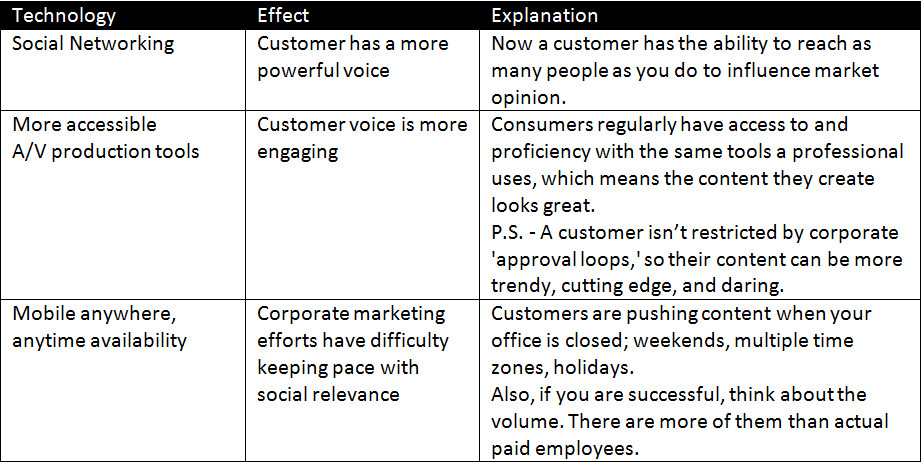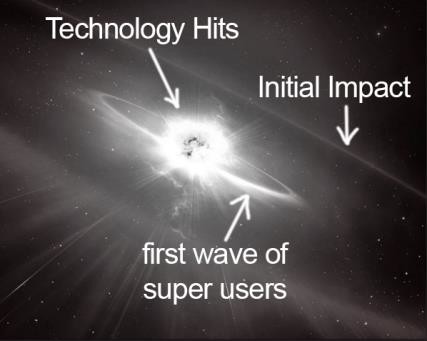Branding, Thought Leadership
How to make opportunities out of brand identity issues. Science fiction meets reality.
SyFy channel’s ‘Dark Matter‘ explores marketing branding issues as classic man vs himself story telling. It’s a branding challenge in the new corporate world order. The premise of the show is that a group of six people awaken from stasis with no memory of who they are. They name themselves in the order of their awakening, One through Six. Waking up with amnesia and seeing yourself as a third party closely parallels what corporate entities are experiencing in today’s new media, techno-savvy landscape.
To understand the correlation, let’s define how corporations built brand personality before the amnesia.
Brand used to be considered a corporation’s outer skin, and its creation and maintenance was the responsibility of the marketing department. Brand efforts were one directional, initiated by the company and pushed outward, delivering a customer’s experience. Consistency was key and the customer played the role of a receiver in the brand equation. (Appearance + Actions + Associations = Brand) Think of it as a classic movie star, like John Wayne. You have a good idea of the experience you are going to have, even if you have never seen his movies.

Let’s explore what is causing the amnesia effect.
Consider the ways that technology has changed the customer’s role from a receiver to a participant in your brand equation:

Granted, “new technology” is relative. With any advancement, there’s a learning curve that creates a delay between the general availability of the technology and the first wave of advanced users.

We are experiencing that first wave. The effect is like looking into a mirror held up by our customers and not recognizing the corporate identity staring back at us. Anyone overly sensitive to ‘Dark Matter’ Season 1 spoilers, can tap out now. The effect is like waking up with amnesia. For Dark Matter’s characters Two through Six, this is an opportunity to change their history; become something better moving forward.
Here’s the kicker. You can be like the characters on ‘Dark Matter,’ and use this opportunity to reevaluate your brand. Decide what elements to keep, change, or nix. For a strong brand like Coke, the effect is akin to seeing yourself on TV for the first time and thinking, “Huh, so that’s me? I like that guy!” But consider Doc Martin: The product and brand were originally designed to serve as sturdy products for British gardeners, until a customer segment they never considered offered them a different view of who they were. They embraced that change in a powerful way to become the symbol of a cultural movement.
But we don’t all work for the top 10%, companies with strong world-renowned brands. It’s much more likely you work for a brand like the ‘Dark Matters’ character, One. On the surface, he appears to be a notorious thief and Raza crew member Jace Corso. But his DNA tells a different tale, in which he is do-gooder high- powered CEO, Derrick Moss. To apply the brand equation, he has the appearance and associations of Jace Corso, but not the means or DNA to live up to that brand. In a quirky little twist of fate, he cannot be Derrick Moss either because he lacks the associations and appearance required to sustain the brand successfully. Amnesia isn’t an opportunity to improve himself, it’s an identity crisis.
Let’s play One’s brand confusion dilemma out in a corporate scenario.
Imagine a customer care employee working for an established, profitable company. Marketing has equipped him with polished print collateral and matching email options to send to customers. But internal workflow for his job is to log the contact info of customers he sends information to onto paper slips that are collected weekly by a marketing intern and handed to members of a sales team. He is faced daily with delivering a customer experience. He has the appearance (digital or physical marketing collateral options) and association (established company that has been in business for several years) of a brand that operates professionally, but not the internal DNA (CRM technology or best business practices). Customers notice this, and the brand doesn’t just take a hit for internal issues. You quickly lose customer confidence, and it no longer matters that your products were solid.
It’s not often that entertainment depicts such a complex identity problem. The character One faces challenges from both of his pasts. His journey isn’t one of self-improvement, it’s an exercise in self-discovery. While I can’t offer the One character from ‘Dark Matters’ any sage advice, here is some insight for corporate entities. Stop thinking of brand as an external function or a marketing endodermal layer, and shift to viewing brand as a heart beat. An internal pulmonary system that pumps through all departments and out into your customer advocates.

A fundamental shift of this magnitude won’t be easy, but it is the key to success. Everyone in your company will need to change how they approach brand and marketing’s role.
Marketing brand efforts will shift towards educating, influencing, and inspiring other departments to understand what your brand is, why it is powerful, and what that could look like from each department’s seat.
This will enable that Customer Care employee to identify why he isn’t leaving the customer truly satisfied, and motivate him to identify issues and potential solutions to management for what he needs in order to deliver the right branded customer experience.
Unity is important. As all the other departments in the company understand and start owning their piece in the brand customer experience, you will greatly minimize brand confusion. This will lead to your customers identifying common themes that define your brand and emulating those themes in the content they publish.
When your customers start publishing content representing your brand in line with what is desired, that’s when you know you are doing it right.








Leave a reply